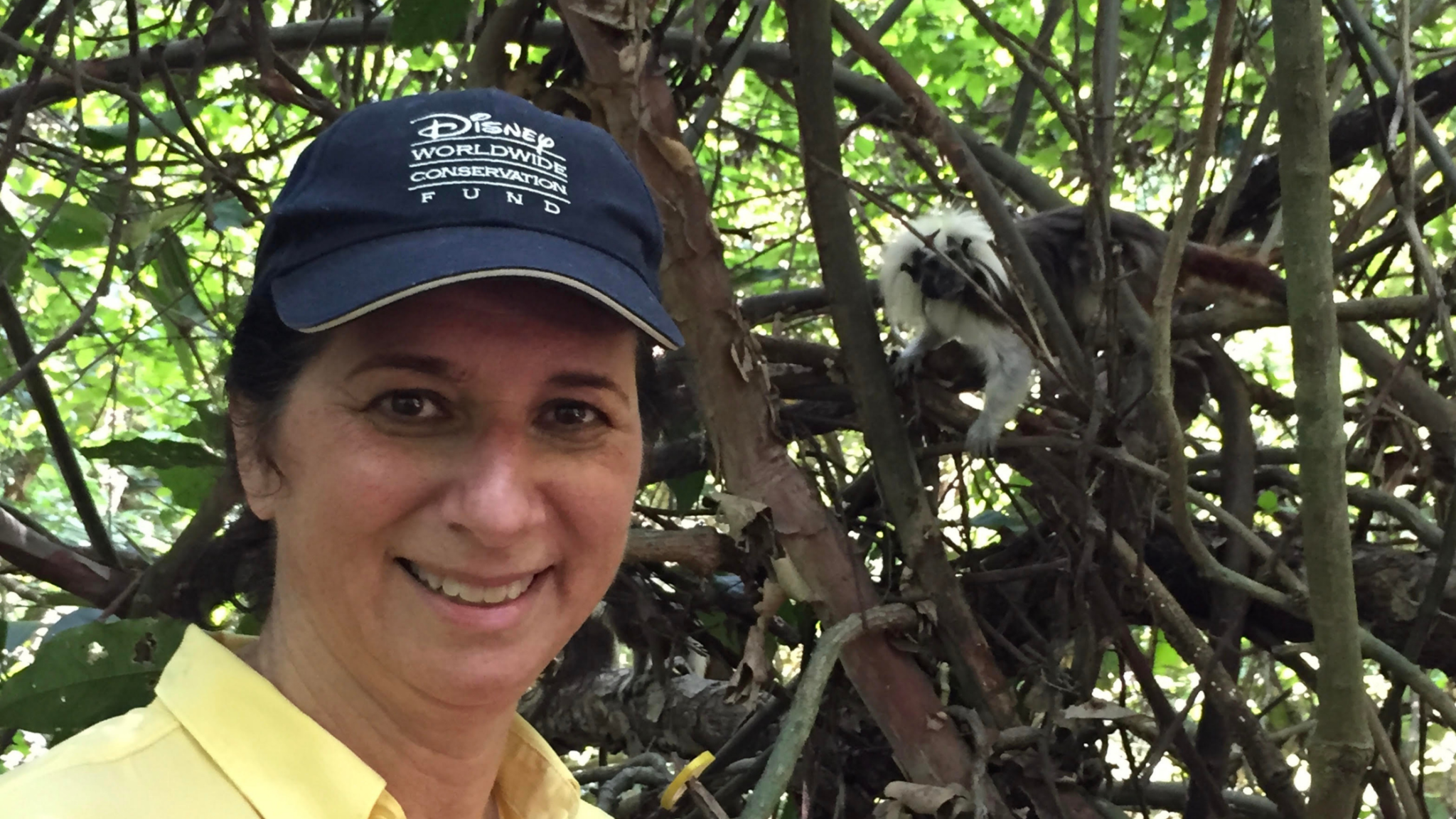
Saving a One-pound Monkey takes Creativity
Dr. Anne Savage didn’t plan to spend 40 years studying and trying to save the Cotton-top Tamarin in Colombia. After studying cotton-tops as a graduate student, she found that mobilizing communities was the only way to reverse forces leading to extinction and she helped found Proyecto Titi, a non-profit now run by Colombians. Here she talks about the importance of community conservation and how it draws on thinking “outside the box”.
How did you get into conservation?
When I started out as an undergraduate at the University of Wisconsin, I thought I was going to be a clinical psychologist. But my introductory psychology instructor was a professor of primatology, and his lecture on primates hooked me.
As I continued my career, my major professor, Dr Charles Snowdon, was an amazing mentor and he introduced me to the world of cotton-top tamarins. With his support, I was able to start the very first long-term field study of cotton-top tamarins in the country of Colombia.
While there were many efforts to conserve this species in managed care, I realized that if I wanted to help save cotton-top tamarins, it needed to happen in-country. When I went to Colombia for the first time very few people understood that cotton-tops were an endangered species.
It became clear to me that it didn’t matter how many Americans in the U.S. were interested in saving this animal, we needed to get Colombians involved in wanting to save cotton-top tamarins. That’s really how it all started for me.
When did you realize that this kind of community-based conservation was necessary?
It was when I made my first trip to Colombia and was working on my Ph.D. thesis. I was beginning to understand what factors were influencing the survival of the species, and one of most common misconceptions was that people in Colombia thought that they could have cotton-tops as pets without negatively impacting the wild population.
Most people in rural communities had no idea how the pet trade and habitat destruction were impacting the survival of wildlife. It became clear that we needed to work to inspire people to care about this species, and also to show them the benefits of protecting forests for people as well.

A cotton-top tamarin. Credit: Chase Pickering.
How does Proyecto Titi help guarantee the long-term survival of the cotton-top tamarin and its habitat?
We have a multi-disciplinary approach to building a successful conservation program in Colombia. We study cotton-tops, monitor the population and understand what factors are influencing their survival. How is the population faring? Are the animals continuing to thrive by successfully reproducing?
We also work with youth to inspire them to care about cotton-tops. We have a series of educational programs starting in elementary school through high school. We even have opportunities for students to come back and work with us on various short-term projects.
It’s fun to have some of our kids that have gone through our early education programs come back and help out on various activities or take the information they learned from us to become educators at the zoo in Bogota, or work in local and governmental agencies. It’s exciting to see how we have also inspired others, like local and international artists who are now sharing the need to conserve cotton-tops with new audiences.
We also have sustainable community development programs that focus on adults. One of our most successful programs has been working with artisans that have formed a cooperative to take recycled material and turn it into something beautiful. They’ve crocheted plastic bags that were littering the environment into tote bags called eco-mochilas that are now being sold within Colombia and in the United States.
The artisans are working with Colombian fashion designers, and you can see their products in some of the retail stores in Cartagena. They were just invited to Paris as part of an exchange between Colombia and France. They’ve now moved from eco-mochilas to making light fixtures and other products crocheted from plastic.
We also have artisans that are making plush cotton-top tamarin toys. When we first started working in Colombia, there were no plush toys. If a child wanted to have some type of representation of a cotton-top, they would get a wild one as a pet. We wanted to be able to substitute wild cotton-tops for plush cotton-tops.
We also have a forest preservation and restoration program. We have protected more than 10,000 acres of forest habitat for cotton-top tamarins. We either purchased land or we helped other partners in Colombia and Colombian governmental agencies to set aside protected land for cotton-tops.
We’re in the process of connecting a lot of these isolated forest patches within the historic distribution of cotton-tops. We have a program in the area of San Juan Nepomuceno that is connecting small forest patches to create forest corridors to a national park where cotton-tops are found. We also work with local farmers and create an agreement where they set aside a portion of their land in a conservation easement and we work with them to better their agricultural production efforts by enhancing their farming techniques. It’s been a win-win for everybody.

Primatologist Anne Savage with cotton-top tamarin. Credit: Proyecto Titi.
What do you like most about this career and what do you find most challenging?
The most exciting things and challenging thing is coming up with creative solutions to conservation. When you work in conservation, you have to come up with creative solutions for a lot of different things that impact not only cotton-top tamarins but people.
As someone who is an expert in cotton-top tamarin behaviour, I never thought I would pivot to working on creative solutions in sustainable development such as teaching women to crochet beautiful tote bags called eco-mochilas out of recycled plastic bags!
It’s really important that you leverage your resources and build partnerships. I never thought I’d be working in ecotourism or with culinary experts to teach our communities how to create dishes that highlight local cuisine and are presented in a manner that really emphasize the culture in rural Colombia. I really like thinking outside of the box and making connections with new people that we can bring into our family of cotton-top tamarin conservationists.
Flexibility and adaptability are the key to success as things change rapidly in this field. You can be most successful if you can connect various disciplines together to help solve challenges and create new opportunities that benefit wildlife and people.
Conservation is really all about influencing people. You may be drawn to the field because of your interest in flora and fauna, but ultimately, the key to saving these species is getting people to change their behaviour so that they value and protect nature.

Credit: Proyecto Titi.
Is the cotton-top tamarin a keystone species? And how does it affect its ecosystem?
Cotton-top tamarins are an important species in tropical forests. Given their small size, they are prey for many raptors and snakes. But they play an important role in forest conservation.
I remember walking through the forest one day and I was looking through binoculars and saw red on the face of a cotton-top tamarin. I thought for sure that it was dried blood. And then I noticed that this cotton-top put its face in these feathery-like structures surrounding a flowering plant. A few seconds later it would look up and start sneezing and I realized that the red was really pollen all over its face!
That was a very fun discovery for me to watch unfold in the forest. Cotton-top tamarins can pollinate certain plants in the forest!
Cotton-tops also play an important role in protecting their own forest habitat by dispersing seeds. Fruits compose the majority of their diet and they can swallow seeds that are about the size of a peanut. That’s equivalent to us swallowing an avocado pit! The seeds pass through their gut and when they defecate the seeds fall to the forest floor and germinate into new plants. Cotton-tops are responsible for helping to spread seeds throughout their forest home.

Cotton-top tamarin ‘Rolando’. Credit: Proyecto Titi.
What do you like most about cotton-top tamarins?
They keep me very entertained and I’m still learning more about them each and every day! When I met my first cotton-top I was 19 years old I never thought I would be spending my entire life studying them or working to protect them for the future. But here I am, over 40 years later, and I’m still fascinated by them and working hard to ensure that they continue to have a future in the wild.
Conservationists are talking about trying to save 30% of wildlife habitats globally by 2030. Do you think these kinds of projects, like Proyecto Titi, are the key to doing that?
There are many ways to save habitat and meet this goal by 2030. First, you must have governmental support to protect and maintain habitat for wildlife. But we also need local support and that where organizations like Proyecto Titi can play an important role.
Individual actions go a long way when it comes to protecting wildlife and their habitat. The more people we can inspire to care about cotton-tops, the fewer animals will be in the pet trade and hopefully more people will be joining us in protecting and restoring forests for this critically endangered species.
I understand that 60% of the world’s primates are endangered. What do we need to do to save them that we’re not doing now?
We need to get people to care about nature. You only save things that you care about, so we have to make conservation of species and habitats a priority in the hearts and minds of people. Conserving nature is vitally important for the survival and happiness of humankind.
What advice would you give to people who would like to work in community conservation?
I think patience is a virtue, particularly if you’re working in other countries. Working in Colombia is very different from working in the United States. But there are many similarities, most importantly in how we need to build a culture of conservation that shows the benefits to everyone about why they should be involved in caring for nature. We need to inspire people around the world to care about our future and the planet.
I think if people are interested in working in community conservation, it’s critically important that you’re working with people in-country and helping to build capacity because in-country nationals are the people that are ultimately responsible for leading the protection of their natural resources.
Everyone can play a part in community conservation efforts. Support conservation organizations like Proyecto Titi, Inc. because everyone can make a difference in helping to save wildlife wherever they live.
If you are interested in finding out more about community conservation check out our webinar, Community-based Conservation, or read more community conservation interviews.
You can also check out The pros and cons of being a primatologist, where we interview three primatologists about their careers.
Author Profile | Bill Boteler
 Bill is a conservationist living in Maryland, USA, who does freelance jobs with groups such as the Jane Goodall Institute. His specialty, so far, is researching information, interviewing people and writing it up. He has interviewed some fascinating people to help update their projects in Jane Goodall’s books. Previously, he was an admin assistant in a conservation coalition. Bill likes to grow indoor and outdoor plants and attract wildlife to the yard.
Bill is a conservationist living in Maryland, USA, who does freelance jobs with groups such as the Jane Goodall Institute. His specialty, so far, is researching information, interviewing people and writing it up. He has interviewed some fascinating people to help update their projects in Jane Goodall’s books. Previously, he was an admin assistant in a conservation coalition. Bill likes to grow indoor and outdoor plants and attract wildlife to the yard.Featured image credit: Proyecto Titi.

